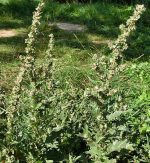 Native to saline and alkaline deserts of Middle and western Central Asia, Asia Minor, North Africa, and Eastern Europe, this annual shrub is a member of the amaranth family, Amaranthaceae, that also includes spinach, beet, and celosia. It grows up to 5′ tall, is much branched and forms a tangled or spreading mass with branches sometimes horizontal on the ground. The alternate leaves are .6-2″ long, obovate to triangular, and have variable sinuate-dentate margins. Clusters of small inconspicuous male and female flowers are carried on the same plant from mid summer into fall. The staminate flowers are in terminal, leafless, spike-like inflorescences while 3-20 pistillate flowers are whorled together in the leaf axils. The leaves and plants are sometimes eaten as emergency food during desperate times and the seeds may be ground and used as a thickener in bread making. Plants may be a source of potash and are medicinally useful but are often considered invasive where introduced. The genus name, Atriplex, is the Greek name for orach, a related plant that can be used as spinach. The specific epithet, tatarica, is the new Latin word meaning of Central Asia, and refers to the geographic distribution of the plant.
Native to saline and alkaline deserts of Middle and western Central Asia, Asia Minor, North Africa, and Eastern Europe, this annual shrub is a member of the amaranth family, Amaranthaceae, that also includes spinach, beet, and celosia. It grows up to 5′ tall, is much branched and forms a tangled or spreading mass with branches sometimes horizontal on the ground. The alternate leaves are .6-2″ long, obovate to triangular, and have variable sinuate-dentate margins. Clusters of small inconspicuous male and female flowers are carried on the same plant from mid summer into fall. The staminate flowers are in terminal, leafless, spike-like inflorescences while 3-20 pistillate flowers are whorled together in the leaf axils. The leaves and plants are sometimes eaten as emergency food during desperate times and the seeds may be ground and used as a thickener in bread making. Plants may be a source of potash and are medicinally useful but are often considered invasive where introduced. The genus name, Atriplex, is the Greek name for orach, a related plant that can be used as spinach. The specific epithet, tatarica, is the new Latin word meaning of Central Asia, and refers to the geographic distribution of the plant.
Type: Annual shrub
Outstanding Feature: Tolerance of drought and very alkaline and saline soil
Form: Tangled mass
Growth Rate: Rapid
Bloom: Clusters of male and female flowers in the same plant from mid summer into fall
Size: 5′ H
Light: Full sun
Soil: Average to lean, medium moist, well-drained; tolerates drought and very alkaline and saline soil
Hardiness: Not relevant
Care: Low maintenance
Pests and Diseases: Not available
Propagation: Seed
Outstanding Selections: None
Photo Credit: Gabriele Kothe Heinrich Wikipedia